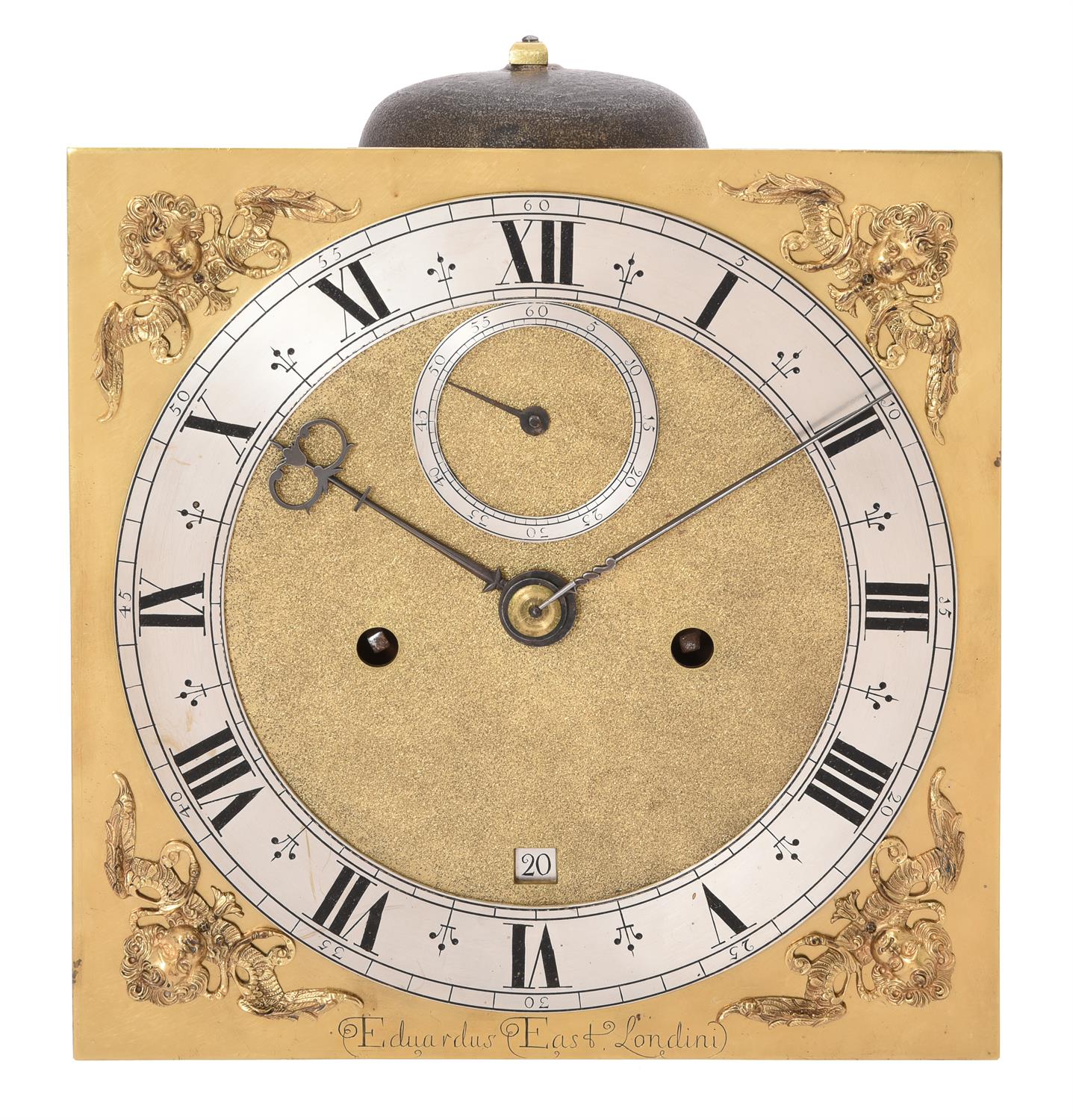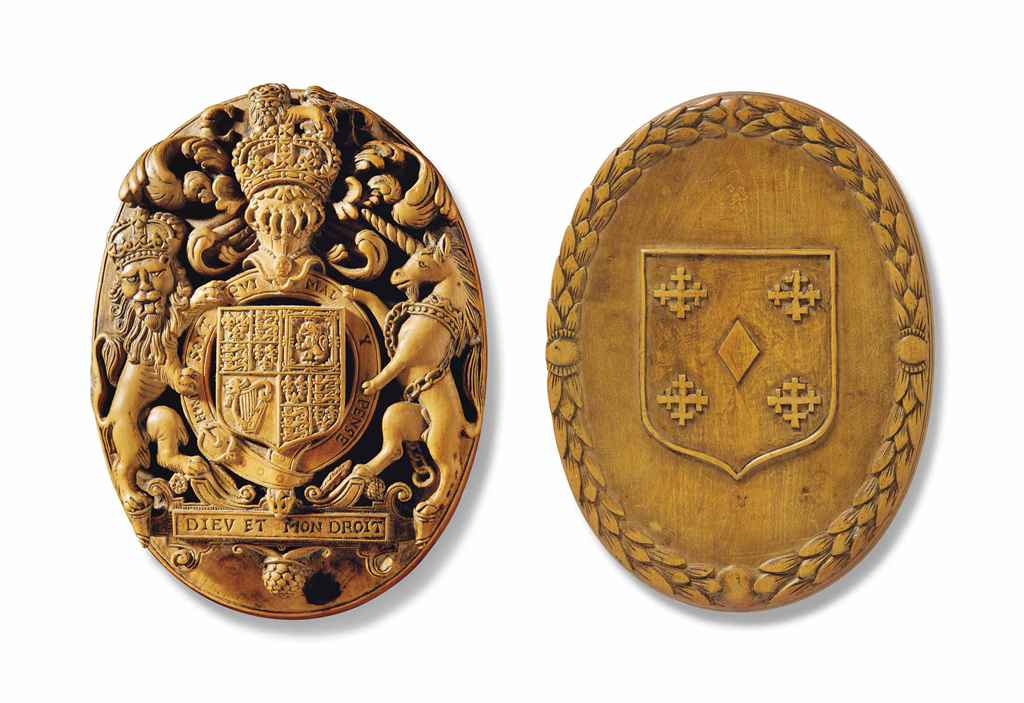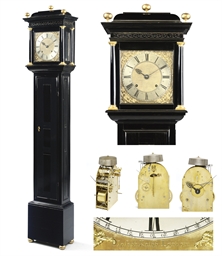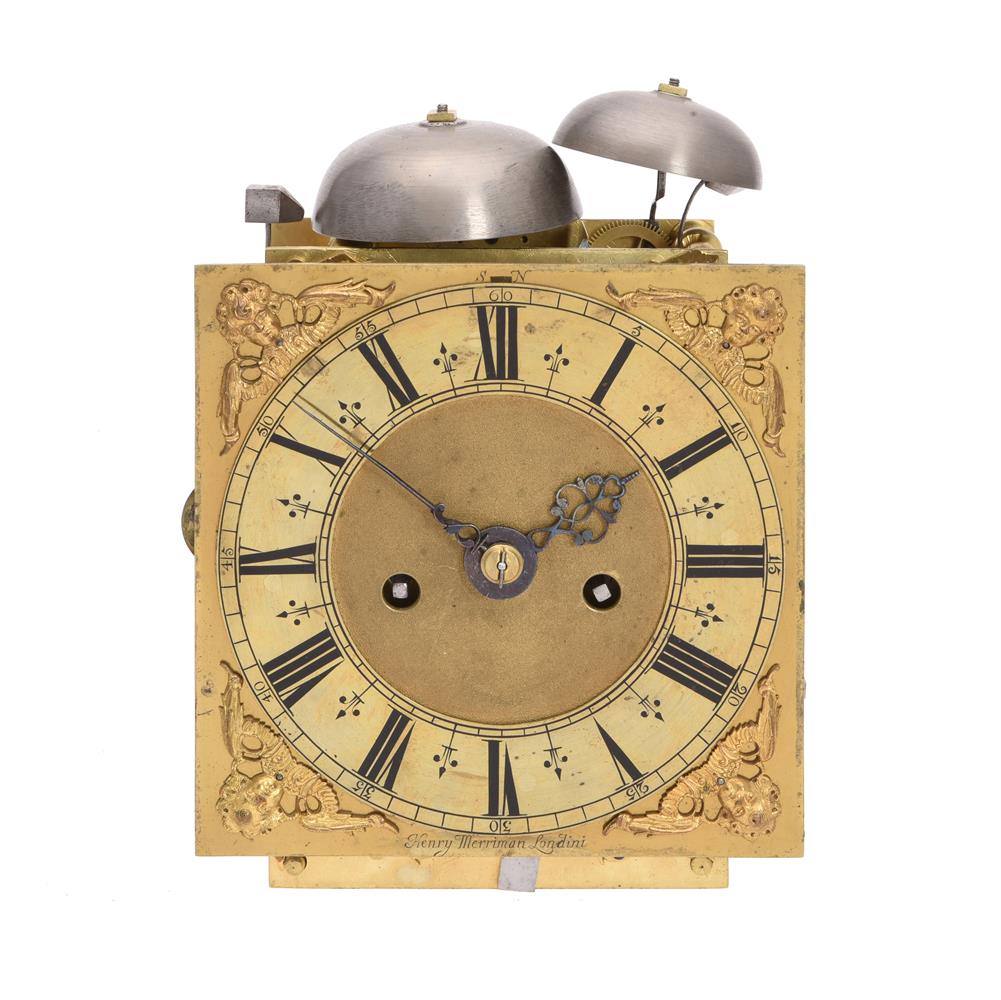A fine Charles II gilt brass mounted ebony small basket top table clock with pull-quarter repeat Charles Gretton London, circa 1680 The five finned pillar twin fusee bell striking movement with pull-quarter repeat on a single bell, the going train with verge escapement regulated by short bob pendulum, the strike train with counting via early double-cut sprung rack gathered away from the snail via pallet engaging with teeth cut to the underside opposing locking enabled by pawl to the upper set of teeth, the fine symmetrical flowering tulip engraved backplate with foliate engraved apron to backcock over drapery lambrequin cartouche signed Charles Gretton in Fleete Street and visible mainspring barrel set-up clicks with pawls held by elaborate scroll-cut brass spring, the 6.25 inch square brass dial with high position winding holes to the matted centre within applied silvered Roman numeral chapter ring with squat stylised fleur-de-lys half hour markers and Arabic five minutes within the narrow outer minute track, with pierced steel hands and winged cherub mask cast brass spandrels to angles, the ebony veneered case with hinged tied floral bud shouldered brass handle to the foliate scroll and husk swag relief decorated pierced domed 'basket' caddy surmount flanked by ball finials over smooth ovolo top moulding and plain glazed front door, the sides with conforming rectangular windows, the rear with further rectangular glazed door set within the frame of the case, the base with shallow ovolo moulded skirt over brass disc feet, 29cm (11.5ins) high excluding handle. Charles Gretton is recorded in Loomes, Brian Clockmakers of Britain 1286-1700 as born in Claypole, Lincolnshire in 1648. He was apprenticed to Humphrey Downing from June 1662 until 1670 but did not gain his Freedom of the Clockmakers' Company until 1672. Gretton married Mary Phillips in 1677, however by 1695 he was a widower hence his second marriage to Lucy Uffman in 1700. By 1683 Charles Gretton was working at The Ship in Fleet Street, and in 1685 he is noted as 'in Fleet Street over against Sergeants Inn Gate'. He was made Assistant of the Clockmakers' Company in 1689, Warden in 1697, and Master in 1700. He took on many apprentices including Henry Sully (Freed April 1705) and Joseph Antram (Freed October 1706) both of whom went on to become famous clockmakers in their own right. In 1701 Gretton put £50 forward to the Clockmakers' Company in order to establish a trust to assist the orphans of deceased members. He died in 1731 leaving his business to be continued by his nephew William Moore The life and work of Charles Gretton is currently receiving detailed attention by Dennis Radage and Warner Meinen for a forthcoming publication. The current lot is a fine early example of Gretton's work and incorporates the earliest form of rack striking where the double-cut rack is gathered away from the snail by a pallet to the lower set of teeth whilst being held by a hook engaging with the upper set. This system requires separate locking of the train which is enabled by a detent raised by a flag engaging with a pin fitted to the end of the rack. Prior to striking the rack hook is released by a pin fitted to the minute wheel and is held in warning by a pair of detents lifted by another pin to a second minute wheel (fitted behind the hour wheel). This layout is essentially identical to that seen on a clock by Robert Seignior described and illustrated in Dawson, Percy G., Drover, C.B. and Parkes D.W. Early English Clocks pages 352-60, plates 512-7. In addition to this unusual and particularly early form of rack striking, the current lot also has a similar shaped bent-brass escape wheel top cock to that seen the example by Robert Seignior; this would suggest that both probably originated form the same workshop. The visible spring set-up clicks (incorporating elaborate brass spring for the pawls) to the backplate echoes the work of Henry Jones and is a detail which appears to have b
A fine Charles II gilt brass mounted ebony small basket top table clock with pull-quarter repeat Charles Gretton London, circa 1680 The five finned pillar twin fusee bell striking movement with pull-quarter repeat on a single bell, the going train with verge escapement regulated by short bob pendulum, the strike train with counting via early double-cut sprung rack gathered away from the snail via pallet engaging with teeth cut to the underside opposing locking enabled by pawl to the upper set of teeth, the fine symmetrical flowering tulip engraved backplate with foliate engraved apron to backcock over drapery lambrequin cartouche signed Charles Gretton in Fleete Street and visible mainspring barrel set-up clicks with pawls held by elaborate scroll-cut brass spring, the 6.25 inch square brass dial with high position winding holes to the matted centre within applied silvered Roman numeral chapter ring with squat stylised fleur-de-lys half hour markers and Arabic five minutes within the narrow outer minute track, with pierced steel hands and winged cherub mask cast brass spandrels to angles, the ebony veneered case with hinged tied floral bud shouldered brass handle to the foliate scroll and husk swag relief decorated pierced domed 'basket' caddy surmount flanked by ball finials over smooth ovolo top moulding and plain glazed front door, the sides with conforming rectangular windows, the rear with further rectangular glazed door set within the frame of the case, the base with shallow ovolo moulded skirt over brass disc feet, 29cm (11.5ins) high excluding handle. Charles Gretton is recorded in Loomes, Brian Clockmakers of Britain 1286-1700 as born in Claypole, Lincolnshire in 1648. He was apprenticed to Humphrey Downing from June 1662 until 1670 but did not gain his Freedom of the Clockmakers' Company until 1672. Gretton married Mary Phillips in 1677, however by 1695 he was a widower hence his second marriage to Lucy Uffman in 1700. By 1683 Charles Gretton was working at The Ship in Fleet Street, and in 1685 he is noted as 'in Fleet Street over against Sergeants Inn Gate'. He was made Assistant of the Clockmakers' Company in 1689, Warden in 1697, and Master in 1700. He took on many apprentices including Henry Sully (Freed April 1705) and Joseph Antram (Freed October 1706) both of whom went on to become famous clockmakers in their own right. In 1701 Gretton put £50 forward to the Clockmakers' Company in order to establish a trust to assist the orphans of deceased members. He died in 1731 leaving his business to be continued by his nephew William Moore The life and work of Charles Gretton is currently receiving detailed attention by Dennis Radage and Warner Meinen for a forthcoming publication. The current lot is a fine early example of Gretton's work and incorporates the earliest form of rack striking where the double-cut rack is gathered away from the snail by a pallet to the lower set of teeth whilst being held by a hook engaging with the upper set. This system requires separate locking of the train which is enabled by a detent raised by a flag engaging with a pin fitted to the end of the rack. Prior to striking the rack hook is released by a pin fitted to the minute wheel and is held in warning by a pair of detents lifted by another pin to a second minute wheel (fitted behind the hour wheel). This layout is essentially identical to that seen on a clock by Robert Seignior described and illustrated in Dawson, Percy G., Drover, C.B. and Parkes D.W. Early English Clocks pages 352-60, plates 512-7. In addition to this unusual and particularly early form of rack striking, the current lot also has a similar shaped bent-brass escape wheel top cock to that seen the example by Robert Seignior; this would suggest that both probably originated form the same workshop. The visible spring set-up clicks (incorporating elaborate brass spring for the pawls) to the backplate echoes the work of Henry Jones and is a detail which appears to have b















Testen Sie LotSearch und seine Premium-Features 7 Tage - ohne Kosten!
Lassen Sie sich automatisch über neue Objekte in kommenden Auktionen benachrichtigen.
Suchauftrag anlegen